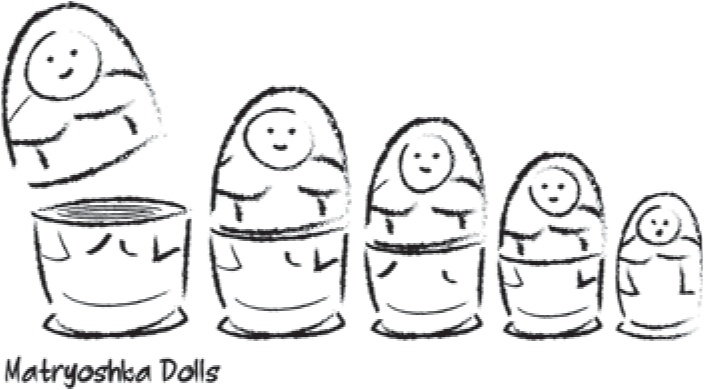If you were to poke around the shops of Moscow, Saint Petersburg, or a Russian neighborhood in your nearest city, you may find a gorgeously carved little metaphor waiting for you on a shelf: the matryoshka doll, what might more commonly be called a nesting doll.
These dolls nest in this sense: on first taking it in, you’ll find a peasant girl or woman in traditional garb, typically wearing a long, flowing dress called a sarafan. But that charming figure is more than meets the eye; should you meet her with your hands, you’ll find that she opens up and another doll is inside. And then that doll opens up into another doll, and that one into another, on and on until you reach the smallest doll, carved from a single piece of wood—usually a baby. What appeared to be one figure was in fact many, layered inside one another like an onion, with each outer layer containing a smaller doll and each smaller doll supporting the outer layer. What appeared to be one was actually several but also, in a way, one.

Organizations are matryoshka dolls: what appears to be one solid thing is actually several. One appearance is brought about by many. In the case of for-profit business, the outermost layer— that charming peasant girl—is the long-term health of the organization. Then, the revenue over time. But there is another layer: the way that society, the customers, users, and other humans interact with the organization and perhaps buy its products. But there’s another layer within that: the product. And another layer again: the team that built the product. And another layer within that: the culture that brought together the team. And another layer within that: the psychology, the inner life, of the founders or leaders of the organization. Their mental lives inform the culture, which informs the hires, which informs the product, which informs people’s interactions with the company, which shapes the brand, which brings in revenue, which allows the company to thrive—or not.
Somewhere along that causality is a movement from the quantitative to the qualitative. The profits the company makes are, of course, tangible: they show up in a spreadsheet. But the causes that created those profits are not: there are no analytics, at least that we know of, that totally capture the inner lives of the people who made the profits. That subtle, private life is not something that translates into spreadsheets very well, but it does predict bottom lines, as we’ll discover in just a moment.
Why is this the case? Because, we think, it has something to do with the era that we are currently in. Disruption is a word that is popular in the business world: it’s used to describe the action of one company being able to provide a value—say, a product or service—much cheaper or at a much greater level of quality than the company currently in that space, which is usually called an incumbent. Often that is thought to be the result of a jump in technology—for example, the Internet, which catalyzed the rise of Netflix and the fall of Blockbuster in the United States—though we’ll later explore how it’s really the fault of the organization’s fixed, unadaptive structure.
To put it dramatically, this evidences a shift in the priorities of the world. We previously lived in an era in which optimization and its implied rigidity was the only game in town, but we now live in a time of creativity, innovation, and sustainability—for these are the skills organizations need to be continually adaptive. The question hidden within that need for continued adaptability, in the same way the matryoshka baby is hidden within the peasant girl, is what kind of psychological practices predict creativity, which social behaviors predict innovation, and which organizational structures lead to the sustainability of all these things.
The mission of this book is to find out.
